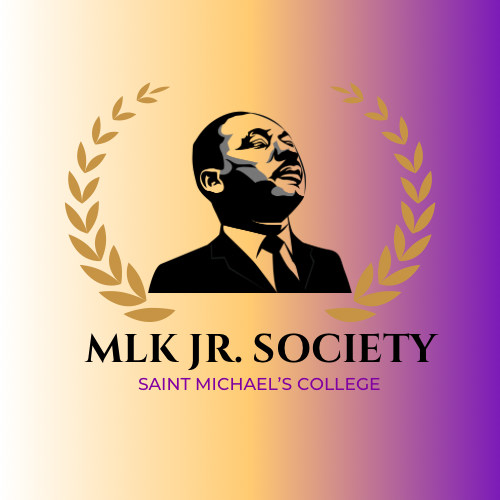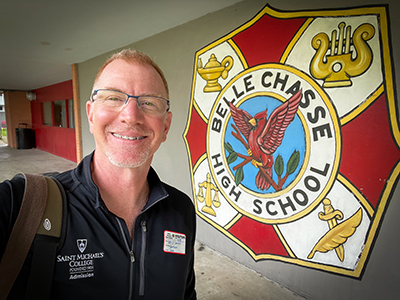Transition to ‘tobacco-free’ campus gains visibility
As with individual smokers, college campuses benefit from a plan and ample support on the road to becoming “tobacco-free.”
That’s why Mary Masson, Student Health Services director, was setting up tables in the Alliot lobby beside the main student cafeteria right before lunch on Tuesday, Nov. 17, to officially launch a public transitional phase that will lead to Saint Michael’s College being tobacco-free beginning September 1, 2016.
On three tables forming a U-shape to the left of the Alliot entrance, she was offering “kits” in clear plastic bags — nicotine replacement gum, stress balls to squeeze, rubber bands for something to do with the hands, small “coping cards” with tips for getting by an urge to smoke – all to help smokers among faculty, staff and students who sign on to join the “Great American Smoke-Out” on Thursday. The annual event invites smokers to quit for just one day. “If you can quit for one day it’s the first step,” said Masson, who also put out food to command the attention of passing students; she also displayed colorful posters and made informative literature available. Several students stopped by and took kits or pamphlets in the first 15 minutes.
College leaders came around too to lend support, including President Jack Neuhauser, Human Resources Vice President Michael New and several Student Life leaders. “It’s truly important for the health of the community, and since we say we’re a good community let’s see if we really can do it,” President Neuhauser said.
On a large screen right next to the president and Health Center director, a video, recently produced by the Health Center along with the Marketing Department, was looping. Several minutes long, it features the president, Masson and others from the community explaining why Saint Michael’s decided to move gradually toward changing the campus culture surrounding smoking.
A new page on the College website explains the origins: In the Spring of 2015, The Tobacco Free Task Force at Saint Michael’s adopted a tobacco and smoke-free campus policy to make campus 100 percent tobacco-free effective September 1, 2016. A message from President Neuhauser at the site explains how the move is partly a response to a call by Vermont’s Health Commissioner Dr. Harry Chen three years ago for all the state’s colleges to work toward being smoke-free. Masson and New headed the task force, with broad representation of the entire College community.
“We are doing this because of the overwhelming effect this will have on the health of our entire community,” states Neuhauser in his web page message. “We know that for some,this will not be easy and we have no intention of being punitive. We will use this academic year to support community members … through education and cessation programs.” Therapy and nicotine replacement will be part of services offered too, he states.
With Masson in Alliot Tuesday was Mariah Sanderson, director of the Burlington Partnership for a Healthy Community and coordinator of the Tobacco-Free College Campus Initiative. She said Vermont campuses were a shade behind campuses nationally in moving to be smoke-free. “Right now about 1,600 campuses are smoke-free and 900 are completely tobacco-free (including smokeless tobacco products).” The University of Vermont went smoke-free in August, she said, and other Vermont campuses are working toward it as at Saint Michael’s with a gradual adjustment period.
Based on the experiences of other campuses, Masson and Sanderson said, the Saint Michael’s gradual and supportive approach mirrors the most effective way of going smoke-free.
“What we’re hearing back from campuses that have done it is that it’s reducing litter on campus significantly since the biggest litter is usually cigarette butts,” Sanderson said, “and it’s also reducing fires as well as damage from butts to things on campuses,” She said some colleges initially feared it would drive potential students away from applying — but actually, the opposite proved true. “Most people don’t smoke, and in the 18-to-25 age range, just under 20 percent smoke — so 80 percent of the young adult population don’t smoke already, and those that do usually start while on a college campus,” she said. “So being smoke-free is actually improving application numbers since students prefer coming to a place where they can avoid second-hand smoke.”
Sanderson noted that smokers are by now used to being asked not to smoke, citing that Church Street in downtown Burlington went smoke-free in recent months, so resistance is typically minimal. “We all get it — that second-hand smoke has negative impacts on health, so it’s not a surprise to anyone anymore,” she said.
Gabby Elmoussaoui’17, a junior elementary education and psychology major from Malden, MA, and non-smoker, came by the tables and said she strongly agrees with the changes. “I’d thought the rule already in place about how you can smoke 20 feet from campus buildings was good, but smoke still gets in a lot of windows if students. I’ve heard people talk about that — they don’t like the smoke in their windows, and honestly I’m not a big fan of cigarette smoke in my face when I’m walking to class.”
Masson said tobacco cessation classes already have started since this fall on Tuesday in the new Bergeron Health Center, with a handful in attendance. “Sometimes the hardest thing a person will have to do is to stop smoking, so we want to support that … Our goal is not to be 100 percent without any tobacco users on this campus, but to decrease the amount used by one or two percent per year and slowly change the culture to promote health and well-being for all,” she said.
Catherine Welch ’10 of the Student Life Office says campus leaders also will work to assure safety for students who can’t or won’t quit, perhaps by finding a designated place where they can go to smoke that doesn’t involve crossing a busy street to be off-campus. “The thing I focus on is making sure that students who come to Saint Mike’s who haven’t smoked yet don’t get exposed to it here, since now, many are exposed to it socially on the weekend and hanging out with friends” she said, explaining that research shows if students don’t start smoking before age 26, they never will. For both smokers and non-smokers, “we’re trying to provide them the support that we can. That’s what St. Mike’s does,” Welch said.





